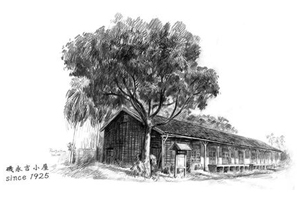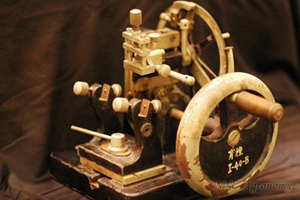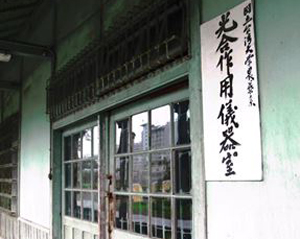:::
Revival of the NTU Eikichi Iso Memorial House:
History of Taiwan’s favorite rice
Many people know that National Taiwan University is the first modern university in Taiwan, but few people know that in the campus sits a historical museum that has a longer history than NTU itself.
 Image from Iso House Facebook page In 1926, Dr. Eikichi Iso, the Father of Taiwanese Japonica rice, and his colleague Suenaga Hitoshi, successfully developed the Ponlai rice, a major staple of the Taiwanese diet. Dr. Iso resided and conducted his research in the Workshop of Advanced Academy of Agronomy and Forestry, an old Japanese style bungalow that has been nicknamed by NTU faculty and students as the “Iso House.” However, along with the passing away of its predecessors, the Iso House was once under threat of demolition.
Ten years ago, Chien-Fu Liu, a then NTU graduate student in the Department of Agronomy, accidentally uncovered Professor Iso’s manuscripts in the darkroom inside the ancient building. As a result of the accidental findings, the Eikichi Iso Historical Association was founded by the faculty and students in the Department of Agronomy. The association organizes workshops, issues the bimonthly newspaper, Rice, and provides guided tours of the Eikichi Iso Memorial House on Wednesdays, Saturdays, and Sundays in hopes that the public will better appreciate and cherish these precious historical treasures.
The accidental Wonder: Ponlai’s “Taichung 65” variety
As one passes through the NTU campus located in the bustling Gonggua area and enters into a pathway next to the farm, one can see that a row of wooden Japanese-style bungalows amidst the rice fields of Taichung 65 is quietly situated next to the NTU Experimental Farm. This 397 sqm building, filled with the memory of Dr. Eikichi Iso, is the Workshop of Advanced Academy of Agronomy and Forestry built in 1925.
Standing in front of the bronze busts of Eikichi Iso and Suenaga Hitoshi, Department of Agronomy technician, Chien-Fu Liu, talks about the little known facts about Ponlai rice. He grins and says, “The creation of the famous rice that we eat today was actually an accident.”
While we may be accustomed to rice that is soft and sticky, it was not until the Japanese rule did this variety appear. In early times, rice cultivated in Taiwan was the polished long-grained non-glutinous rice, or the Indica rice, commonly known as zailaimi. After the arrival of the Japanese government, the Japanese immigrants were not used to eating the dense Indica rice, therefore they made every effort to cultivate the soft, sticky and round-grained Japonica non-glutinous rice that was popular in their hometown.
The area between NTU and National Taiwan University of Science and Technology in today’s Keelung Road used to be the old site of the “Agriculture Test Institute of the Office of the Governor General of Taiwan.” During the Japanese rule, the Iso House was the workshop of the Practice Farm of Taihoku (Taipei) High School of Agriculture and Forestry, which was used as a warehouse for rice and tools. As Dr. Iso conducted research at both sites, a considerable amount of manuscripts and equipments were preserved.
After receiving sovereignty over Taiwan, the Japanese government began introducing several varieties of the Japonica rice to Taiwan. However, as Japanese varieties could not adapt to the island’s subtropical climate and long exposure to sunlight, the breeding was largely unsuccessful. Even though the Japanese varieties cultivated in Taiwan were officially designated as the Ponlai Rice in 1926, the entire crop of the most promising rice variety, the “Nakamura,” died of rice blast the following year.
Around 1920, Suenaga Hitoshi became the director of the Taichung Agricultural Experiment Station. With the support and encouragement of Dr. Eikichi Iso, Hitoshi crossed two Japanese varieties, the “Kameji” and the “Shinriki” in 1924 and thereby, the Taichung 65 (T65) was born in 1929. Characterized by its photo-insensitivity (as it is relatively insensitive to photoperiods, cultivation is not season-bound), T65 became the representative Ponlai variety in Taiwan, surpassing Indica rice within a decade after it was created.
Interestingly, T65 was selected from crossbreeding between two pure Japanese varieties that do not have photo-insensitive characteristics. Speaking of this, Liu smiled and said, “The Japanese were very lucky.” Later research showed that T65’s property of photoperiod insensitivity may have resulted from mixing pollen grains of upland rice from Taiwan’s mountainous areas. If it were not for Hitoshi’s insight to add a “third party” element, the history of Taiwan’s rice would have been entirely different. “This is how researchers make new discoveries,” said Liu.
Hidden Manuscripts: revival of the Eikichi Iso Memorial House
 Photograph from Iso House Facebook page Along with the departure of Professor Eikichi Iso and the political eradication of all Japanese traces after the retrocession of Taiwan, the Eikichi Iso Memorial House receded into history. It was not until 2003 that Chien-Fu Liu, still a graduate student at NTU, found several documents marked with a round stamp inscribed “Iso” while looking for instruments in the filthy darkroom of the house. There were more than 4,000 precious artifacts that Dr. Eikichi Iso stored in this small room of less than 7 sqm.
“At first, I was shocked. Then I was confused, wondering why the items had not been uncovered by other people?” said Liu.
After Dr. Eikichi Iso left Taiwan, several professors in the Department of Agronomy, including Dr. Jeng-Yi Lin, Dr. Kwan-Long Lai, Dr. Mei-Tsang Tseng, continued to conduct research on crop improvement at the Iso House for a lengthy period of time. Nevertheless, the Iso still fall to ruins in the subsequent years, and became a storage room for insignificant items. In addition, because the Kuomintang (KMT) government deliberately erased any traces of Japanese occupation after the Japanese surrendered at the end of World War II, a majority of the department’s faculty had never heard of Dr. Eikichi Iso.
If it were not for Liu, who had just so happened to also be interested in history, the years of buried history would not have been brought to light.
In addition to the manuscripts, more than 200 pieces of oddly shaped agronomic instruments were also unearthed. Sitting on a cement table inside the building is a wooden square box; on top of the box is an iron plate with hundreds of small holes on it, and beneath it is a pair of, even back legs.
“Originally I thought the front legs were missing, but later I realized that it was designed this way,” said Liu while turning the handle of the “grain counter” in his hands.
This particular instrument was used to measure the weight of grains. Through vibration, grains of rice would slip through the small holes upon which the number of grains could be accurately calculated. In the past, people used 1,000 grains as a unit to calculate the weight of seeds; the “grain counter” accurately picks out 1,000 grains of rice so that the weight of each grain can be calculated.
In addition to the “grain counter,” another instrument that examines whether the rice kernels are broken was also uncovered. Other instruments included a tool that examines the grain hardness, a grain sampler, microscopes, and several temperature and humidity testers.
The functions of these instruments were obtained by the faculty and students of the Department of Agronomy, who had laboriously consulted ancient Japanese books, searched the Internet, and even written to experts in Japan just to unveil their mysteries. As most of the antique instruments were made of quality wood or brass, a majority of them are still operational.
“Less than one-fifth of the instruments’ entire collection is on display,” adds Liu. Due to lack of funding and manpower, archaeological verification, repair and maintenance, and management and promotion of historical sites are taken care of by the faculty, students, and volunteers.
Passing down the cultural heritage
 Photograph from Iso House Facebook page One can tell from inside the room that the Eikichi Iso Memorial House is in dire need of maintenance and repair. After Chien-Fu Liu uncovered Dr. Iso’s precious manuscripts in 2003, the newly constructed NTU Library requested that they be taken in as part of the library’s special collections. Yet even then, the house did not receive much attention.
Furthermore, when the new College of Bioresources and Agriculture building was constructed in 2006, the Iso House was at one point at risk of demolition. And even though the Taipei City Government later registered it as a designated historical site in 2009, the Iso House has still not received any consistent funding, and can only rely on minor repair assistance from the University in the name of emergency repairs. The rest is dependent on individual fund-raising efforts.
Fortunately, the building was built with sturdy Asian fir, which is resistant to termites, and the structure is built upon a level ground, which makes it less susceptible to earthquakes and typhoons. Nevertheless, the creaking sounds of the wooden floors have revealed its age and crisis.
In their efforts to preserve the legacy of Eikichi Iso, the faculty and students of the Department of Agronomy restored the house last year and began opening it to the public on Wednesdays, Saturdays and Sundays. The Eikichi Iso Historical Association was also founded, whereby workshops were organized and a publication dedicated to rice and agriculture was created.
Eikichi Iso Memorial House: history of Taiwanese Ponlai rice
So far, the Eikichi Iso Memorial House has received more than five thousand visitors since it opened in June last year. Currently there are 50 to 60 volunteers, some of whom entered the volunteer program after visiting the house, and some of whom are residents in neighboring areas. As there are not many NTU student volunteers, Liu gravely admits that not many students know about the Iso House’s history.
However, there is a group of former NTU students who have an unspeakable gratitude toward the Eikichi Iso Memorial House. When the house fell into decay, it became a dormitory for students with financial difficulties, and at one point housed as many as 7 to 8 people at the same time. On one occasion, a visitor from an agricultural research and extension station exclaimed that he was one of the students who used to live there. Liu jokingly states that he often asks these senior students to write articles for the association’s newspaper publication as a means to repay their “tuition fees.”
Currently there is no full-time staff stationed in the Eikichi Iso Memorial House, and Liu is in charge of managing each and every detail, even though he was one of the very few graduate students in the Department of Agronomy whose research topic was not on rice. After graduation, Liu passed the Civil Service Senior Examination and returned to NTU to work in the NTU Phytotron. He often jokes that he is simultaneously in charge of the university’s most advanced equipments as well as most dated historical building. “It’s fate—returning back to alas conduct research on rice agronomy,” says Liu.
Every few days, Liu winds the key to an ancient clock that was left behind from the Japanese colonial period. As the clock quietly ticks away, the image of Professor Eikichi Iso sitting in the chair, pondering over the breeding of Ponlai rice seems to appear. “Preservation of the house is important not only because Dr. Iso was a pioneering predecessor in the department, but also because rice is a very important part of Taiwanese culture,” says Liu. He hopes that each and every person who consumes rice should come to visit and learn about the history of Taiwan’s unique Ponlai rice.
Visit the Iso House Facebook page HERE, or susbribe to the online Rice publication HERE.
|



